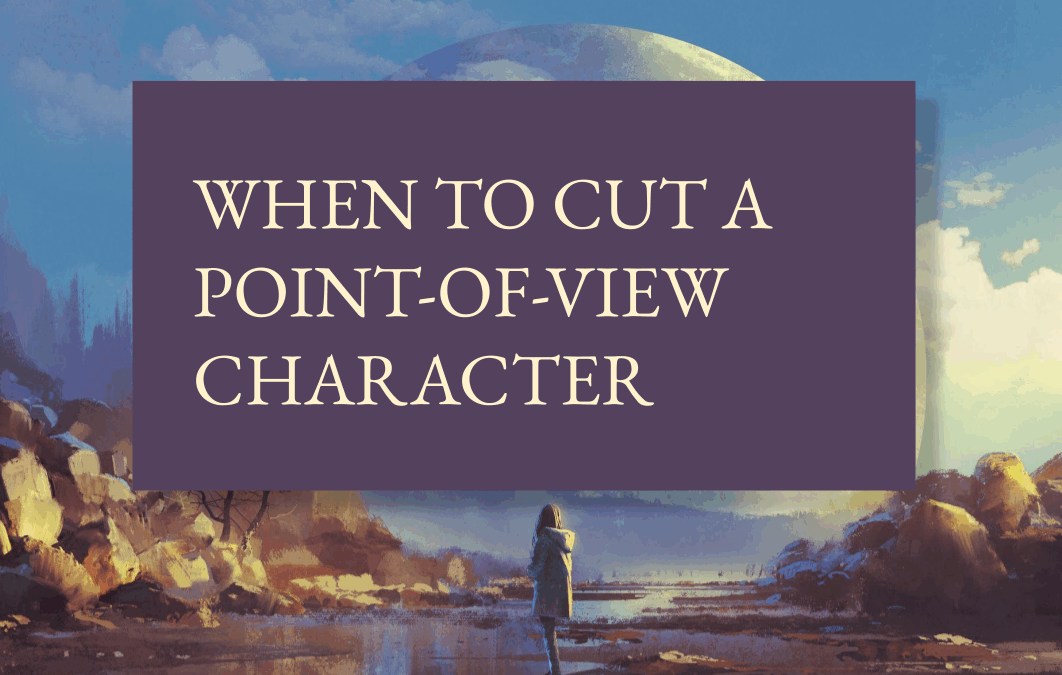It’s the first question a writer must consider after deciding to tell a story with multiple limited points of view (hereafter: a multi-POV story) – which characters deserve their own POV?
Well, it’s the question they should consider.
In reality, newer writers sometimes treat their story’s POVs less as a choice and more as an accident. They like a character and want to spend time with them, so they give them a POV. They want to convey some information, so they write a chapter from the POV of the character who would naturally know it. They know a character is important and, assuming all important characters need a POV, give them one.
But in effective storytelling, POV is as much an artistic, strategic decision as any other aspect of the craft. And like those other aspects, when it’s done haphazardly, it often backfires.
Maybe that’s you, and now you, your critique partners, your editor, or your beta readers feel that a certain character’s POV isn’t working as well as the others. If so, don’t panic, but do prepare for a possibly difficult decision. Here are some symptoms to help you diagnose whether that POV should be cut.
Symptom #1: You already have many POV characters.
It’s hard to put a number on how many is too many. It depends on the story. But there’s a reason we don’t often see more than six POVs in a traditionally published fantasy or science fiction novel. The more POV characters, the more they tax readers’ mental bandwidth. And too many usually results in a diluted story where each POV character’s plot is thin or slow.
(There are exceptions. Look no further than Martin’s A Song of Ice and Fire. But notice that even in such celebrated many-POV works, there are POVs many readers want to skip. This effect is much more pronounced in less skilled writing.)
If your story has many POVs and one isn’t working, chances are that readers, and perhaps you, are overwhelmed by the complexity. Look carefully at what each POV contributes. If the problematic POV character could be enjoyed just as easily from the outside via dialogue and action, they likely don’t need their own POV. If their plot or arc is similar to another POV character’s, they don’t need their own POV. If their POV adds complexity without serving the rest of the story, ask whether that complexity is worth the cognitive load.
Symptom #2: The story’s premise doesn’t support the POV.
The most obvious example is romance. A dual-POV story where each half of a couple has a POV makes sense. The story is about how these people feel about each other, and dual POV gives readers a front-row seat. But if a third POV for one lover’s mother was thrown in? In most romances, the mother will be an unwelcome distraction.
Always ask: Whose POVs are implied by my premise? If your story is about court politics, are all your POV characters connected to the court? If it’s a heist, are they all involved in the big job? Do they all have a stake in your story’s central plot problem?
If your problematic POV character disappears when you summarise your story in a few sentences, it’s very possible that you or readers aren’t vibing with them because they’re not relevant enough. Tacking on a POV from the protagonist’s irrelevant home or work life might seem like it fleshes out the story, but most readers would rather stay focused on what the plot is really about.
Symptom #3: The POV character is there to convey information or witness events.
Giving a character a POV is a commitment. Readers will be in the character’s mind, and that requires making them feel like a fully realised person in a way you don’t need to do for non-POV characters.
This symptom is especially relevant for characters given a POV because they’re in the right place at the right time. They witness plot events or convey exposition that (seemingly) no other POV character could, either because they’re too far away in place or time or because the author wants the information hidden from the other POV characters. These perfunctory POVs don’t affect the plot and don’t have an arc or a motivation of their own – at least not one relevant to the story. They’re there to be a camera. As a result, they’re less engaging than POV characters who matter to the story.
Witnessing a character’s growth also creates attachment. So if you have two POV characters with arcs, goals, and backstories and one who feels like a convenient lens, readers will feel the difference.
You might be able to save the character’s POV by giving them a small arc. More often, though, the remedy is to cut it and devise a way for another POV character to do the witnessing or conveying. We’re writing fantasy and science fiction – we have it easier than most authors when it comes to overcoming limits of time and place! Use tech or magic to your advantage.
As for information you want to keep secret from other POVs, note that this strategy is usually less effective than it sounds. See how the reveal works without readers knowing ahead of time, before concluding that a whole POV is necessary for secrecy.
Symptom #4: The POV is a crutch to generate tension.
This is related to the previous symptom and common with antagonist POVs. For example, from the protagonist’s perspective, whole chapters may pass without substantial plot problems. Meanwhile, the villain’s POV scenes show a high-stakes, urgent evil plan that will, eventually, ruin everything for the clueless protagonist. If only they knew!
Notice what’s happening here. On its own, the tension-generating POV might be compelling (if it doesn’t feel like a tedious teaser) – after all, it’s where the story’s real tension is. The issue is that it compromises the story as a whole by letting the writer avoid making other, more important POVs compelling in their own right. When a writer is told their protagonist’s POV is the least engaging, this is often the problem: the tension is built in other POVs, while the protagonist either doesn’t know about the tense problem yet or isn’t the one tackling it.
If you’ve got a show-stealing POV, especially a non-protagonist one, consider its impact. If cutting it forces other, more important POV characters to deal with plot problems more directly, it may need to go.
Symptom #5: The character isn’t interesting enough to carry a POV.
Harsh, but sometimes true! I’ve worked with writers who included a certain POV because they thought they had to. They weren’t as passionate about that POV character as about the others, and it showed. Those chapters became the ones we both wanted to skim past.
Other times, despite the writer’s enjoyment of them, the character just couldn’t hold their own against more sympathetic or unique POVs and dragged down reader engagement.
Sometimes, this can be fixed with more work on the character. But if the POV also shows other symptoms on this list, the wisest decision may be to cut it.
In the end…
Some characters simply aren’t meant to have a POV in the story you’re writing. If you want to spend more time with such a character, why not create a separate story from their perspective? That way, they can have the spotlight. They might be the perfect protagonist elsewhere!
And if you’re still unsure, look at what your other POV characters have that they don’t and apply all the usual advice for building characters. Then, if the POV still isn’t working, you’ll know it’s not because you didn’t give them enough of a chance. You can cut their POV, and their role as a non-POV character will be stronger for the work you’ve done.
Kahina Necaise is the executive editor of Fabled Planet. She is also a content and line editor for its sister brand for historical fiction, The History Quill. When not editing, she can usually be found working on her own fantasy stories with ancient-history-inspired settings, reading, or going on walks while daydreaming about one of these things.
Do you write fantasy or science fiction?
Join our email list for regular writing tips, resources, and promotions.

